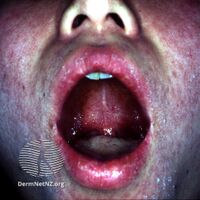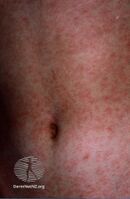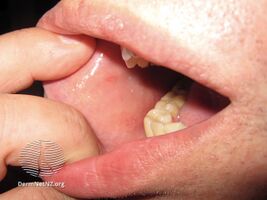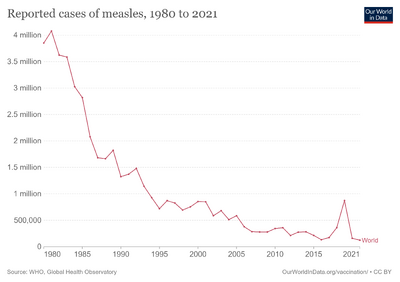Koplik's spots

Koplik's spots (also Koplik's sign) are a prodromic viral enanthem of measles manifesting two to three days before the measles rash itself. They are characterized as clustered, white lesions on the buccal mucosa (opposite the lower 1st & 2nd molars) and are pathognomonic for measles.[2]
Nobel laureate John F. Enders and Thomas Peebles, who first isolated the measles virus, were careful to collect their samples from patients showing Koplik's spots.[3]
Symptoms and signs
The textbook description of Koplik spots is ulcerated mucosal lesions marked by necrosis, neutrophilic exudate, and neovascularization.[4] They are described as appearing like "grains of salt on a reddish background",[1] and often fade as the maculopapular rash develops.
-
Koplik's spots
-
Koplik's spots
-
Koplik's spots
Diagnosis
As well as their diagnostic significance they are important in the control of outbreaks. Their appearance, in context of a diagnosed case, before they reach maximum infectivity, permits isolation of the contacts and greatly aids control of this highly infectious disease.[5]
History
Koplik's spots are named after Henry Koplik (1858-1927), an American pediatrician who published a short description of them in 1896, emphasising their appearance before the skin rash and their value in the differential diagnosis of diseases with which measles might be mistaken.[5][6]
He published two further papers on the spots, including one with a colour illustration.[7]
An anonymous reviewer of Koplik's The Diseases of Infancy and Childhood refers to the illustration as "the now famous coloured plate".[8]
Some authors ascribe the first written description of these spots to Reubold, Würzburg 1854, and others to Johann Andreas Murray (1740-1791). Before Koplik, the German internist Carl Jakob Adolf Christian Gerhardt (1833-1902) in 1874, the Danish physician N. Flindt in 1879, and the Russian Nil Filatov (1847-1902) in 1895, had observed equivalent phenomena.[9]
Koplik was aware of Filatov's work,[10] thought his evidence insufficient and rejected his claim for priority.[7]
References
- ↑ 1.0 1.1 Steichen O, Dautheville S (2009). "Koplik spots in early measles". CMAJ. 180 (5): 583. doi:10.1503/cmaj.080724. ISSN 0820-3946. PMC 2645467. PMID 19255085.
- ↑ Tierney LM, Wang KC (February 2006). "Images in clinical medicine. Koplik's spots". N. Engl. J. Med. 354 (7): 740. doi:10.1056/NEJMicm050576. PMID 16481641.
- ↑ Enders, J.F.; Peebles, T.C. (1954). "Propagation in tissue culture of cytopathogenic agents from patients with measles". Proc. Soc. Exp. Biol. Med. 86 (2): 277–86. doi:10.3181/00379727-86-21073. PMID 13177653. S2CID 4010044.
- ↑ Robbins and Cotran. "Infectious Diseases." Pathologic Basis of Disease. 7th ed. 2005. Print.
- ↑ 5.0 5.1 Baxby, Derrick (July 1997). "Classic Paper: The diagnosis of the invasion of measles from a study of the exanthema as it appears on the buccal mucous membrane". Reviews in Medical Virology. 7 (2): 71–74. doi:10.1002/(SICI)1099-1654(199707)7:2<71::AID-RMV185>3.0.CO;2-S. PMID 10398471.
- ↑ Koplik, H (1896). "The diagnosis of the invasion of measles from a study of the exanthema as it appears on the buccal mucous membrane". Arch Pediatr. 13: 918–22.
- ↑ 7.0 7.1 Koplik, Henry (1899). "the new diagnostic spots of measles on the buccal and labial mucous membranes". Med. News, (NY). 74: 673–6.
- ↑ Anon (1903). "Review; The Diseases of Infancy and Childhood, by Henry Koplik". Lancet. 162 (4171): 389–390. doi:10.1016/s0140-6736(00)67711-5.
- ↑ Koplik, H. "The diagnosis of the invasion of measles from a study of the exanthema as it appears on the buccal mucous membrane" Archived 2017-09-21 at the Wayback Machine, Archives of Pediatrics, New York, 1896; 13: 918-922," (accessed 13 September 2006)
- ↑ Falkener, L (1901). "Fitalow's spots in morbilli". Lancet. 157 (4040): 315–7. doi:10.1016/s0140-6736(01)71368-2. Archived from the original on 2020-01-11. Retrieved 2021-04-07.
Further reading
- Steichen, O; Dautheville, S (Mar 3, 2009). "Koplik spots in early measles". CMAJ : Canadian Medical Association Journal. 180 (5): 583. doi:10.1503/cmaj.080724. PMC 2645467. PMID 19255085.
External links
- Koplik spots in early measles Archived 2021-08-28 at the Wayback Machine - Canadian Medical Association Journal



